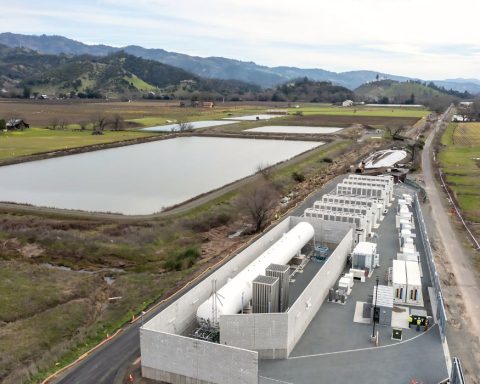It’s early October and actor Mark Ruffalo takes the stage as part of The Nantucket Project, a speakers series in Massachusetts that over the past two years has drawn some of America’s greatest thinkers.
The setting is intimate. He is among friendly faces. But the hunk who played the Hulk in The Avengers action movie is up front with the audience: “I really don’t want to be here. I want to be home with my wife and kids, honestly.”
Yet Ruffalo feels compelled to be there. After witnessing the impact that shale gas fracking is having on water and property in upstate New York, a place he now calls home, Ruffalo has, with some reluctance, become an environmental activist with a mission: to wean the economy off fossil fuels.
“What we’re moving into is the inevitable transition to renewables,” the actor-activist told the room. “This is going to happen, and it’s probably going to happen in our lifetimes. And we can go kicking and screaming, or we can go with some willingness, and grace, and foresight, and planning, and actually be the great innovators that this country promises.”
How to get there? Ruffalo didn’t know when he first started his crusade. As an Oscar-nominated actor, he knew he could get people’s attention. Big-name actors, musicians, artists – they’re all media magnets. When they speak, the public is more likely to hear them, and even listen. “I don’t think you can make big changes without a cultural component,” he said.
But once Ruffalo got that attention, what would he say? How would he back up what he said?
His search for those answers led him to two individuals: Mark Jacobson, a professor of environmental engineering at Stanford University, and Marco Krapels, executive vice-president with Rabobank N.A., part of the Rabobank Group, a century-old financial services cooperative with $1 trillion in assets.
The three chatted, brainstormed, and soon realized they needed each other to convincingly get the message across. Partnering up a famous actor, a top-tier scientist and a credible finance guy – a potent mix of culture, science and finance – made a lot of sense. “It’s a different approach to an environmental issue, and I think one that’s never really been taken,” said Ruffalo. “But I think it’s a winning combination.”
Jacobson was the man with the plan, one famously outlined in 2009 in a cover story he co-authored for Scientific American magazine. The Stanford academic continues to refine it, believing that a blend of “wind, water and sun” – in combination with electric transportation, smart grid technologies and a big push on efficiency – could provide virtually all of the energy the world needs by 2030.
Indeed, Jacobson insists it can be done without nuclear power, without carbon capture and storage technologies, without natural gas and even without biofuels. In his view, those options will only make environmental problems worse when compared to the relatively benign impacts of wind power and other renewables.
That’s partly because Jacobson sees climate change – melting glaciers and sea ice, rising sea levels, and extreme weather – as just one part of the problem.
Pollution, from the chemical cocktail in smog to the particulates emitted from smoke stacks, is just as dangerous, more immediate and visible. “Air pollution alone kills 2.5 to 3 million people at least a year worldwide,” Jacobson said during a presentation last fall in Toronto.
He said nuclear power is nine to 25 times more polluting per kilowatt-hour than wind when the mining and refining of uranium and the use of fossil fuels for construction are taken into account. That number rises to 50 times for natural gas plants and 150 times for coal plants that use carbon capture and storage systems.
But even if the renewables path is better environmentally and doable technically, is that enough? “It has to make business sense. That’s why I came into the mix,” Rabobank’s Krapels told the Nantucket onlookers. “I’m the banker. My clients need to make money.”
Krapels’ role in the trio is to show that investing in renewable energy today does make financial sense and can deliver a pleasant return on investment, on top of all the good karma that comes with generating emission-free power.
It’s an easy sell for Krapels because for him it’s based in reality. With creative financing and subsidies that level the playing field with fossil fuels, renewable energy projects can fetch a 10 per cent return, he said. “I don’t know about you, but I’m not finding a lot out there that’s getting a 10 per cent return.”
Together, Ruffalo, Jacobson and Krapels have spent the past two years developing what’s being called The Solutions Project, which they hope will evolve into a national – and potentially global – movement aimed at powering the economy with 100 per cent green energy.
Their first initiative is aimed at developing a comprehensive plan for New York State, which, after Hurricane Sandy, has plenty of political motivation to act. It’s expected to formally launch in early 2013 and could serve as a template for other states and countries to follow.
To amplify the effort, other artists, scientists and business people have been brought on board to support the project, including actors Scarlett Johansson and Leonardo DiCaprio, Tesla Motors founder Elon Musk, philanthropist Eileen Rockefeller and Gasland director Josh Fox.
Ruffalo said these high-profile supporters collectively have a social network of 12 million followers, giving the initiative tremendous messaging clout. Wrapping up his presentation in Nantucket, he assured the audience that the project, while ambitious, isn’t some left-wing, pinko, treehugger fantasy.
“This isn’t pie-in-the-sky stuff,” he said. “This is actually doable.”
By bringing together a scientific and financial perspective and giving it a cultural boost, Ruffalo’s goal with The Solutions Project is to build enough public support to make it politically palatable.







